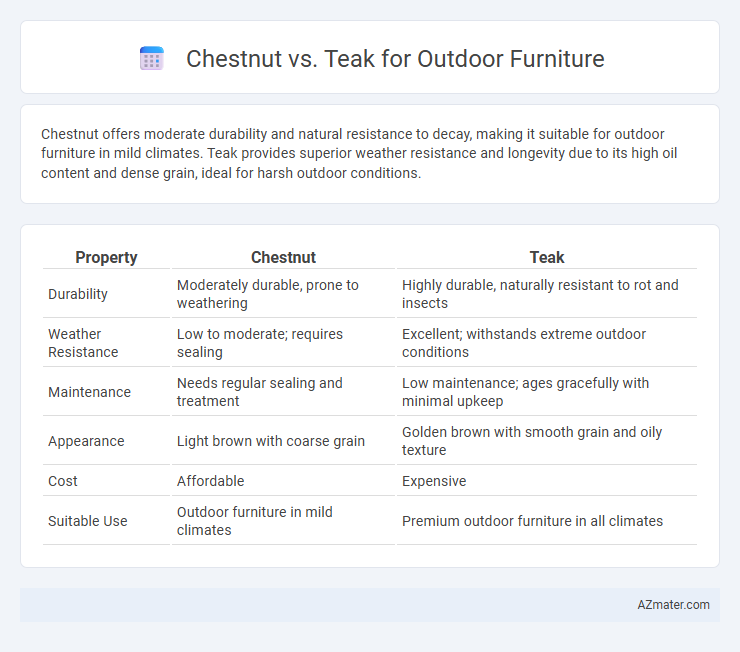Chestnut offers moderate durability and natural resistance to decay, making it suitable for outdoor furniture in mild climates. Teak provides superior weather resistance and longevity due to its high oil content and dense grain, ideal for harsh outdoor conditions.
Table of Comparison
| Property | Chestnut | Teak |
|---|---|---|
| Durability | Moderately durable, prone to weathering | Highly durable, naturally resistant to rot and insects |
| Weather Resistance | Low to moderate; requires sealing | Excellent; withstands extreme outdoor conditions |
| Maintenance | Needs regular sealing and treatment | Low maintenance; ages gracefully with minimal upkeep |
| Appearance | Light brown with coarse grain | Golden brown with smooth grain and oily texture |
| Cost | Affordable | Expensive |
| Suitable Use | Outdoor furniture in mild climates | Premium outdoor furniture in all climates |
Introduction: Chestnut vs Teak for Outdoor Furniture
Chestnut and teak are popular choices for outdoor furniture due to their durability and natural resistance to weather conditions. Teak is renowned for its high oil content, which provides exceptional resistance to moisture, insects, and decay, making it ideal for long-lasting outdoor use. Chestnut offers a more affordable option with good strength and moderate weather resistance, but it requires regular maintenance to prevent deterioration over time.
Key Characteristics of Chestnut Wood
Chestnut wood for outdoor furniture is prized for its exceptional durability and resistance to decay due to its high tannin content, making it naturally weather-resistant and ideal for garden settings. Its coarse texture and straight grain provide an attractive, rustic aesthetic while maintaining strength and flexibility, allowing it to withstand varying outdoor conditions without warping. Chestnut also offers a medium hardness rating, balancing toughness with ease of workability, and its light to medium brown color deepens gracefully with age and exposure to sunlight.
Distinctive Features of Teak Wood
Teak wood stands out in outdoor furniture for its exceptional natural oil content, which provides superior resistance to water, decay, and insect damage compared to chestnut. Its dense grain and high tensile strength offer durability and structural integrity, making teak ideal for withstanding harsh weather conditions. The wood's natural golden-brown hue also weathers to an attractive silver-gray patina, enhancing its aesthetic appeal over time.
Durability and Weather Resistance Comparison
Chestnut wood offers moderate durability and natural resistance to rot and insects, making it suitable for outdoor furniture in mild climates. Teak is renowned for its exceptional durability and high oil content, providing superior weather resistance, including protection against moisture, UV rays, and decay. Teak furniture consistently outperforms chestnut in longevity and maintenance requirements, thriving in harsh outdoor conditions with minimal upkeep.
Maintenance Requirements: Chestnut vs Teak
Chestnut outdoor furniture requires regular sealing or oiling to maintain its durability and prevent moisture damage, while teak furniture naturally resists rot and insect attacks due to its high oil content. Teak demands minimal maintenance, often needing only occasional cleaning and light sanding to preserve its smooth finish. Chestnut, being more porous, is more susceptible to weathering and therefore needs more frequent upkeep to maintain its appearance and structural integrity.
Aesthetics and Color Variations
Chestnut outdoor furniture showcases a warm, reddish-brown hue with natural variations that deepen over time, creating a rich and inviting aesthetic ideal for rustic or traditional settings. Teak offers a golden to medium brown color that gracefully ages to a silvery-gray patina, lending a timeless and sophisticated appeal perfect for contemporary or coastal designs. Both woods provide unique color variations, with chestnut emphasizing earthy tones and teak highlighting subtle, elegant shifts that enhance outdoor living spaces.
Environmental Impact and Sustainability
Chestnut wood, sourced from fast-growing deciduous trees, offers a sustainable option for outdoor furniture due to its rapid renewal and minimal chemical treatment requirements. Teak, valued for its durability and natural oils, comes primarily from tropical rainforests, raising concerns about deforestation and habitat loss when harvested unsustainably. Choosing responsibly certified chestnut or teak, such as FSC or PEFC labels, significantly reduces environmental impact by promoting sustainable forestry practices.
Cost Analysis: Chestnut vs Teak
Chestnut outdoor furniture typically offers a more affordable option compared to teak, with chestnut priced significantly lower due to its faster growth rate and wider availability. Teak's higher cost is justified by its superior durability, natural resistance to weather, and rich oils that prevent decay, making it ideal for long-term outdoor use despite the higher initial investment. When budgeting for outdoor furniture, chestnut provides cost-efficiency for short- to medium-term projects, while teak represents a premium choice for longevity and minimal maintenance.
Suitability for Different Outdoor Climates
Chestnut offers excellent resistance to moisture and moderate durability, making it suitable for temperate and humid climates but less ideal for extremely wet or tropical environments. Teak's natural oils provide superior protection against water, insects, and decay, making it highly durable and ideal for harsh, wet, or coastal outdoor conditions. Both woods require regular maintenance to preserve their appearance and structural integrity in varying climates, with teak generally demanding less frequent care.
Final Verdict: Which is Better for Outdoor Furniture?
Chestnut offers excellent durability and natural resistance to decay, making it a budget-friendly option for outdoor furniture with a warm, rustic appearance. Teak is widely regarded as the best choice due to its exceptional weather resistance, high oil content preventing rot and insects, and minimal maintenance requirements. For long-term investment in premium outdoor furniture, teak provides superior longevity and aesthetic appeal compared to chestnut.

Infographic: Chestnut vs Teak for Outdoor Furniture
 azmater.com
azmater.com